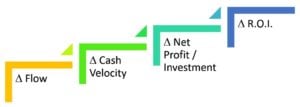So, a colleague of mine was asking some questions about how he might help his small-to-midsized business enterprise clients improve their supply chain and inventory management within Sage 100. Knowing that many of these small businesses have grown organically, and may lack a lot of formal training in inventory management theory, I offered the following in my response.

Let’s start with the basics: What does the client need to know about every SKU-Location (SKUL)?
Inventory Lead Time
- They need to know the actual lead times (not guesses). And they can only get that information is the data in their system is reasonably accurate. For example, a purchase order generated on October 2, that isn’t released until October 10, is only valuable for calculating actual lead times if they know the release date, not the create date. Lead times need to be measured from when the vendor becomes aware of the demand.
- If internal lead times (the time from internal awareness of demand and the release of the replenishment order) is significant, it should be tracked independently and managed to as small a time period as possible.
- They need to know their lead time variability. This is a simple calculation of ratio between the average lead time for a SKUL and the standard deviation in lead time for the same SKUL. (Statistically, this is known as the CV or coefficient of variation and is calculated as StdDeviation/Mean.) It’s one thing to say the average lead time for a SKUL is “10 days” with a variability of one or two days. It’s a completely other matter to manage inventory for a SKUL with an average lead time of 10 days, where the variability is minus 2 to plus 14 days.
- They need to know the difference between full lead time and ASRLT (Actively Synchronized Replenishment Lead Time) for each SKUL. It is only by knowing these factors that they can strategically position their inventory for maximum ROI.
- They need to know the range of lead times across their supply chain so they can appropriately manage inventory profiles. A “short” lead-time in one supply chain might be one to three days, whereas a “short” lead-time in another company’s supply chain might be one to three weeks.
Average Daily Usage (ADU)
- They need to know the ADU for every SKUL in their system.
- They need to know that the ADU is kept up-to-date. In today’s economy, an ADU calculated two months ago may not be accurate for today, especially if it is being factored by long lead times (large multipliers).
- They need to be able to identify and quantify sporadic demand. Factoring for sporadic demand is really pretty easy to do, even it T-SQL code. Take the number of days out of the last 365 where demand was non-zero. Divide that number into 365. For example, if a specific SKU had 41 days with non-zero demand in the last 365 days, you would take 365 days / 41 orders = 8.9 days per order (or, an order about every 9 days). We then take the square-root of that number (9^0.5 = 3) and use it in our calculations of “safety stock” or RED ZONE, and the Order Spike Threshold. You can read more about the details in an article I posted on the Supply Chain Community blog or read here for an alternative approach to sporadic demand.
Demand Variability
- They need to know the demand variability (CV of demand) for each SKUL. Demand variability, like lead time variability, is a simple calculation of the ratio between average daily demand and the standard deviation in daily demand.NOTE: These calculations can be quickly and accurately done using Transact-SQL’s standard capabilities for both demand and lead times, provided the data are reasonably accurate.NOTE: Like lead times, they need to be able to separate SKUs into “families” by knowing demand variability across their range of SKUs. In one company, a CV in demand of 0.2 might be considered “medium” variability; whereas, in another company, a CV in demand of 0.8 might be considered “medium.” Again, where these factors are used with long lead times (large multipliers), it can make a significant difference in inventories.
Minimum Order Quantities (MOQs)
- They need to know the true MOQs for each SKUL. By true MOQ, we mean the smallest economically sensible replenishment order quantity (not a number somebody picked out of their hat because they believe it is “efficient” to use that number).
- They need to know (at least internally) the why behind the MOQ. (They want to avoid large MOQs that are based on some calculation of “efficiency” that leads to constant or recurring disruptions to the more crucial—profit-making—matter of FLOW.)
Order Spike Threshold
It is crucial to know what single-day demand quantity for any given SKUL requires special attention. This is the order spike threshold and should be up-to-date so that supply chain planners receive appropriate alerts for demand exceeding the threshold.
Fortunately, solutions like Sage Inventory Advisor automate (using different nomenclature, or without “naming” the concept at all) the consideration of many of these factors. If the users are attempting to use Sage 100 in its native state, they will need lots of assistance if they are ever going to get out of, and stay out of, “firefighting” mode in their supply chain operations.
If they want an even better solution, they should consider Replenishment+, for any number of reasons—the largest reason being a history of producing huge ROI for companies that use it.
In the absence of any external solution, there would be a lot of statistical analysis that would have to be built “from scratch” to help the typical company become anything more than an “also ran” in their industry and marketplace.
https://www.rklesolutions.com/get-in-touch/
I have questions regarding inventory management within my Sage software. Be sure to contact us with your questions or for help.
I Need Sage Support »



